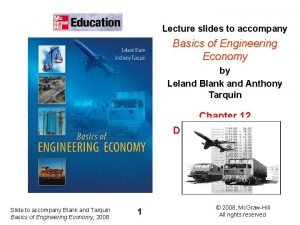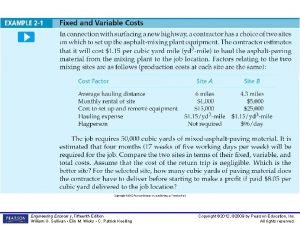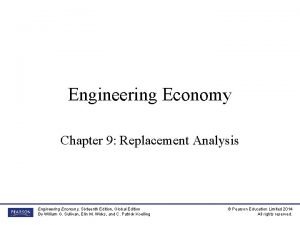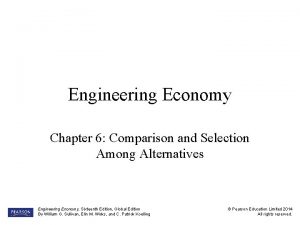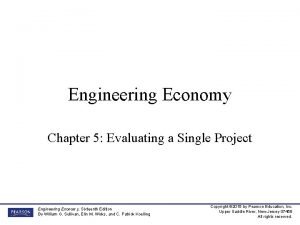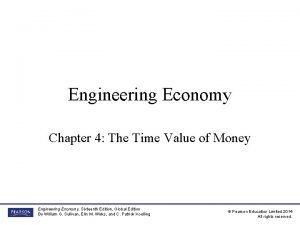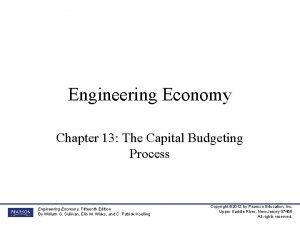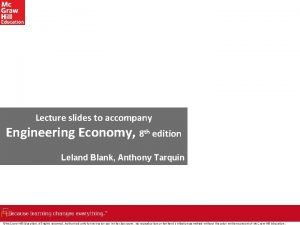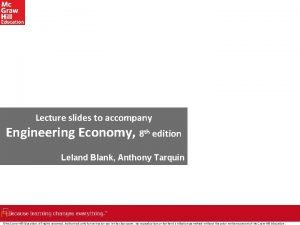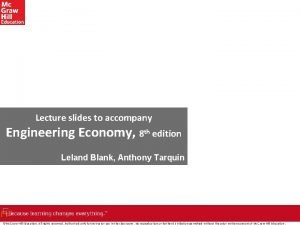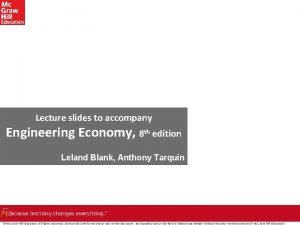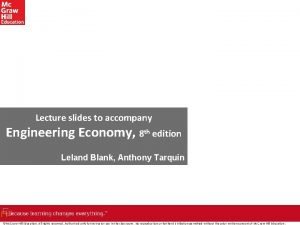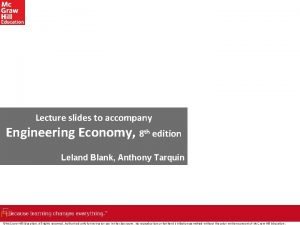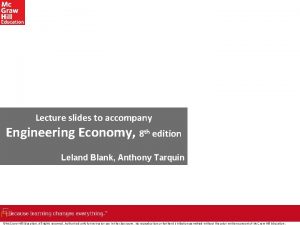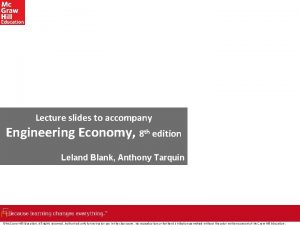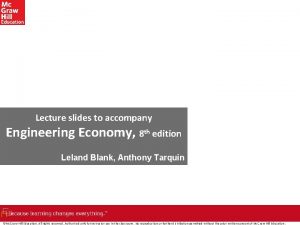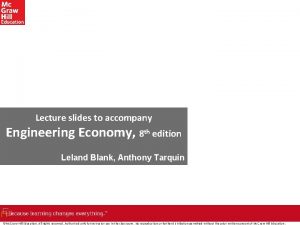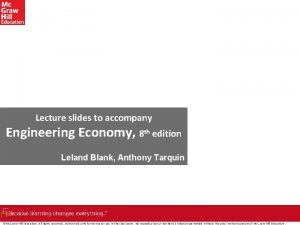Lecture slides to accompany Engineering Economy 8 th

















- Slides: 17

Lecture slides to accompany Engineering Economy, 8 th edition Leland Blank, Anthony Tarquin ©Mc. Graw-Hill Education. All rights reserved. Authorized only for instructor use in the classroom. No reproduction or further distribution permitted without the prior written consent of Mc. Graw-Hill Education.

Chapter 11 Retention and Replacement ©Mc. Graw-Hill Education. All rights reserved. Authorized only for instructor use in the classroom. No reproduction or further distribution permitted without the prior written consent of Mc. Graw-Hill Education.

LEARNING OUTCOMES 1. Explain replacement terminology and basics 2. Determine economic service life (ESL) 3. Perform replacement/retention study 4. Understand special situations in replacement 5. Perform replacement study over specified time 6. Calculate trade-in value of defender ©Mc. Graw-Hill Education.

Replacement Study Basics Reasons for replacement study 1. Reduced performance 2. Altered requirements 3. Obsolescence Terminology Defender – Currently installed asset Challenger – Potential replacement for defender Market value (MV) – Value of defender if sold in open market Economic service life – No. of years at which lowest AW of cost occurs Defender first cost – MV of defender; used as its first cost (P) in analysis Challenger first cost – Capital to recover for challenger (usually its P value) ©Mc. Graw-Hill Education.

Example: Replacement Basics An asset purchased 2 years ago for $40, 000 is harder to maintain than expected. It can be sold now for $12, 000 or kept for a maximum of 2 more years, in which case its operating cost will be $20, 000 each year, with a salvage value of $9, 000 two years from now. A suitable challenger will have a first cost of $60, 000 with an annual operating cost of $4, 100 per year and a salvage value of $15, 000 after 5 years. Determine the values of P, A, n, and S for the defender and challenger for an AW analysis. • ©Mc. Graw-Hill Education.

Overview of a Replacement Study Replacement studies are applications of the AW method Study periods (planning horizons) are either specified or unlimited Assumptions for unlimited study period: 1. Services provided for indefinite future 2. Challenger is best available now and for future, and will be repeated in future life cycles 3. Cost estimates for each life cycle for defender and challenger remain the same If study period is specified, assumptions do not hold Replacement study procedures differ for the two cases ©Mc. Graw-Hill Education.

Economic Service Life Economic service life (ESL) refers to the asset retention time (n) that yields its lowest equivalent AW • ©Mc. Graw-Hill Education.

Example: Economic Service Life • Year • • Cost, $/year 0 1 2 3 4 5 Salvage value, $ n/a 10, 000 8, 000 5, 000 3, 000 • Economic service life is 4 ©Mc. Graw-Hill Education. •

Performing a Replacement Study ©Mc. Graw-Hill Education.

Performing a Replacement Study − Unlimited Study Period 1. Calculate AWD and AWC based on their ESL; select lower AW 2. If AWC was selected in step (1), keep for n. C years (i. e. , economic service life of challenger); if AWD was selected, keep defender one more year and then repeat analysis (i. e. , one-year-later analysis) 3. As long as all estimates remain current in succeeding years, keep defender until n. D is reached, and then replace defender with best challenger 4. If any estimates change before n. D is reached, repeat steps (1)Ifthrough (4) Note: study period is specified, perform steps (1) through (4) only through end of study period ©Mc. Graw-Hill Education.

Example: Replacement Analysis • An asset purchased 2 years ago for $40, 000 is harder to maintain than expected. It can be sold now for $12, 000 or kept for a maximum of 2 more years, in which case its operating cost will be $20, 000 each year, with a salvage value of $10, 000 after 1 year or $9000 after two years. A suitable challenger will have an annual worth of $-24, 000 per year. At an interest rate of 10% per year, should the defender be replaced now, one year from now, or two years from now? ©Mc. Graw-Hill Education.

Additional Considerations Opportunity cost approach is the procedure that was previously presented for obtaining P for the defender. The opportunity cost is the money foregone by keeping the defender (i. e. , not selling it). This approach is always correct Cash flow approach subtracts income received from sale of defender from first cost of challenger. Potential problems with cash flow approach: • Provides falsely low value for capital recovery of challenger • Can’t be used if remaining life of defender is not same as that of challenger ©Mc. Graw-Hill Education.

Replacement Analysis Over Specified Study Period Same procedure as before, except calculate AW values over study period instead of over ESL years of n. D and n. C • It is necessary to develop all viable defenderchallenger combinations and calculate AW or PW for each one over the study period • Select option with lowest cost or highest income ©Mc. Graw-Hill Education.

Example: Replacement Analysis; Specified Period An asset purchased 2 years ago for $40, 000 is harder to maintain than expected. It can be sold now for $12, 000 or kept for a maximum of 2 more years, in which case its operating cost will be $20, 000 each year, with a salvage value of $10, 000 after 1 year or $9000 after two. A suitable challenger will have an annual worth of $-24, 000 per year. At an interest rate of 10% per year and over a study period of exactly 2 years, determine when the defender • should be replaced. Option 1 (C, C, C) 2 (D, C, C) ©Mc. Graw-Hill Education. Year 1, $ Year 2, $ Year 3, $ AW, $ Decision: Option 3; Keep D for 2 years, then replace

Replacement Value Replacement value (RV) is market/trade-in value of defender that renders AWD and AWC equal to each other • • ©Mc. Graw-Hill Education.

Example: Replacement Value An asset purchased 2 years ago for $40, 000 is harder to maintain than expected. It can be sold now for $12, 000 or kept for a maximum of 2 more years, in which case its operating cost will be $20, 000 each year, with a salvage value of $10, 000 at the end of year two. A suitable challenger will have an initial cost of $65, 000, an annual cost of $15, 000, and a salvage value of $18, 000 after its 5 year life. Determine the RV of the defender that will render its AW equal to that of the challenger, using an interest rate of 10% • per year. Recommend a course of action. ©Mc. Graw-Hill Education.

Summary of Important Points In replacement study, P for presently-owned asset is its market value Economic service life is the n value that yields lowest AW In replacement study, if no study period is specified, calculate AW over the respective life of each alternative Opportunity cost approach is correct, it recognizes money foregone by keeping the defender, not by reducing challenger’s first cost When study period is specified, must consider all viable defender -challenger combinations in analysis Replacement value (RV) is P value for defender that renders its AW equal to that of challenger ©Mc. Graw-Hill Education.
 Hebrews 6 9
Hebrews 6 9 Accompany chapter 1
Accompany chapter 1 Rotter's node
Rotter's node Inkjet printers are considered legacy technology
Inkjet printers are considered legacy technology Athens and sparta were both
Athens and sparta were both A small child slides down the four frictionless slides
A small child slides down the four frictionless slides A crane lowers a girder into place at constant speed
A crane lowers a girder into place at constant speed Principles of economics powerpoint lecture slides
Principles of economics powerpoint lecture slides Introduction to machine learning ethem alpaydın
Introduction to machine learning ethem alpaydın Business communication lecture slides
Business communication lecture slides 01:640:244 lecture notes - lecture 15: plat, idah, farad
01:640:244 lecture notes - lecture 15: plat, idah, farad Engineering economy
Engineering economy Engineering economy 15th edition
Engineering economy 15th edition Engineering economy
Engineering economy Comparing alternatives engineering economy
Comparing alternatives engineering economy Engineering economy 16th edition chapter 5 solutions
Engineering economy 16th edition chapter 5 solutions Deffered annuity
Deffered annuity Engineering economy
Engineering economy











